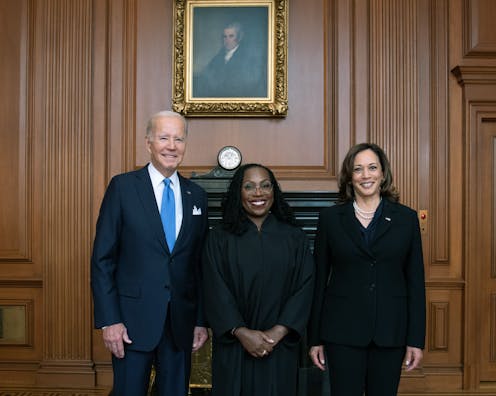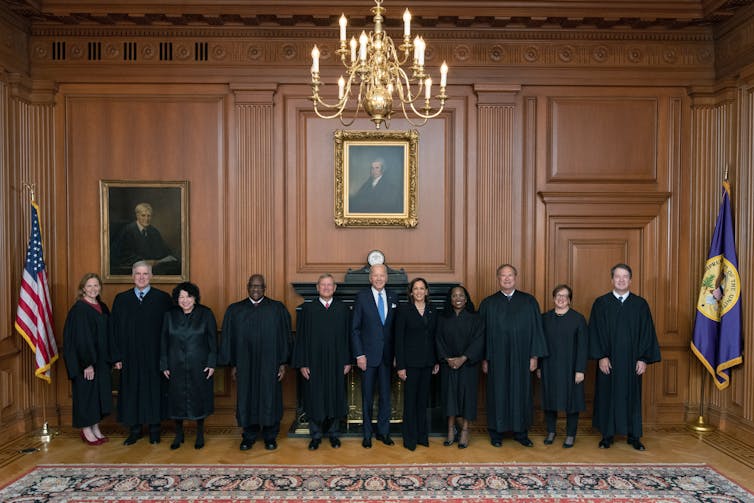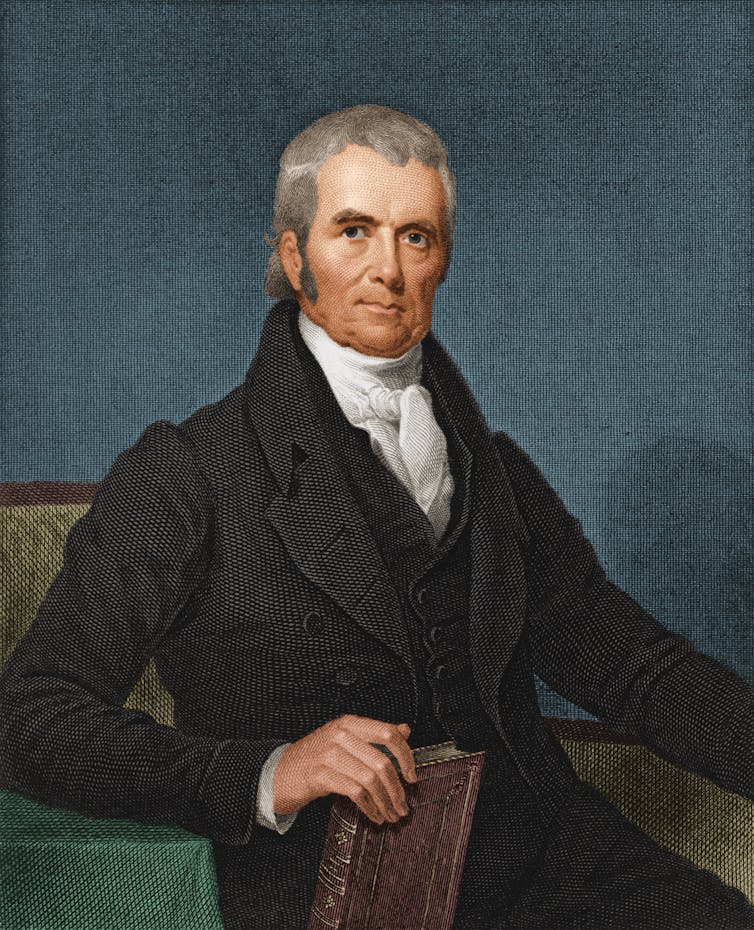A President Harris might not get any Supreme Court picks – Biden proposes term limits to make sure a
A scholar of the Supreme Court and its relationship to the people of the United States says that President Joe Biden’s proposed term limits for justices can restore the court’s eroded legitimacy.

To emphasize the importance of an election, presidential candidates often predict that the next president will have an opportunity to fill one or two vacancies on the U.S. Supreme Court.
But in the case of a hypothetical President Kamala Harris, this may not be true. Even if Harris were to win in November 2024, and then win reelection in 2028, she may not have a chance to reshape the court by filling the seat of a departing justice, especially a conservative one.
Jimmy Carter was the only one-term president who didn’t fill a Supreme Court vacancy. No president who won reelection has been denied this opportunity. In contrast, President Donald Trump was able to appoint three justices in a single term.
This inconsistency is one of the reasons why President Joe Biden’s call for Supreme Court reform, which Vice President Harris supports, should be considered a meaningful attempt to address a relatively new development that has diminished the ability of the people – through their elected representatives in the White House and the Senate – to shape an unelected Supreme Court.
Biden’s reform plan, outlined in an op-ed and a speech at the LBJ Presidential Library in Austin, Texas, includes two major legislative elements: 18-year term limits for justices and a “binding code of conduct” for the court’s members. The former proposal is particularly relevant for the future makeup of the court and the presidential election in November.

The Supreme Court’s place in American democracy
While every child in America learns in school of the Supreme Court’s independence, historically the justices have not been walled off from the larger world, issuing decisions while wearing political blinders.
Instead, they have been aligned with the enduring political regimes that dominated much of American history. Consider, for example, Thomas Jefferson’s Democratic-Republican Party and Abraham Lincoln’s Republican Party. Each party won six presidential elections in a row. Franklin D. Roosevelt’s Democratic Party won five straight presidential elections. From 1968-1992, Republicans won five of six presidential elections.
The court’s alignment with a dominant regime mattered greatly for American democracy. It was the primary reason political scientist Robert McCloskey concluded in his widely read book, “The American Supreme Court,” first published in 1960, that the justices rarely “lagged far behind nor forged far ahead of America.” Instead, McCloskey concluded, the court had typically stayed in line “with the mainstreams of American life and seldom overestimated its own power resources.”
A great deal has changed in the six-plus decades since McCloskey wrote those words. As I argue in my recently published book, “A Supreme Court Unlike Any Other: The Deepening Divide Between the Justices and the People,” those changes have undermined the court’s democratic legitimacy because the electoral link that once existed doesn’t anymore. Democratic candidates have won the popular vote in seven of the past eight presidential elections. Yet, six of the nine current justices have been appointed by Republican presidents.

One of the key changes has been the length of time justices serve today. Consider that when Chief Justice John Marshall died in 1835, he set a record for service – at 34 years and five months – that would only be surpassed by one justice over the next 140 years. Indeed, from 1789 to 1971, justices served just over 16 years on average.
Today, however, presidents of both parties choose young nominees – generally around 50 – with the expectation that they will serve several decades. As I write in my book, “if the justices of today stay on their current course, Marshall’s mark will become commonplace. Assuming all stay on the Court until their eighty-fifth birthday – a few months older than the mean age of the last five justices to depart – they will have served thirty-three years on average.”
No change for another decade?
Consider that soon after he won his brutal confirmation fight in 1991 at the young age of 43, Clarence Thomas pledged to serve until he was 86. While those words were spoken long ago and may not be fulfilled, they highlight a central concern about the court’s place in American democracy today.
To help explain, let’s take Thomas at his word, and assume for a moment that he’s able and indeed does fulfill that promise he made long ago.
That would mean that at 76, Thomas – currently the oldest justice – would stay on the court for another decade. As noted above, this is not a wild assumption, as justices routinely stay on the court well into their 80s. Recall that Ruth Bader Ginsburg was 87 when she died in 2020. John Paul Stevens was 90 when he retired in 2010.
Let’s further assume that none of the other eight younger justices die or retire before Thomas. That would mean there would not be another Supreme Court vacancy until 2034, when Thomas departs after 43 years – nearly seven years longer than the current record, held by William O. Douglas.
It would also mean that if Harris were elected to the presidency in November and reelected in 2028, she would not have an opportunity to alter the court.
The court and political change
Enabling change is a centerpiece of democracy. But in choosing the like-minded youthful nominees intended to serve for decades, presidents hope to insulate policy from the ballot box.
Presidents admit as much by often saying that one of the most significant decisions they make in the Oval Office is their selections for the Supreme Court.
Why? It’s because those presidents understand that the justices will continue to affect American law and politics long after their presidencies have come to an end and long after the elections they won have faded from our collective memories.
For much of American history, justices served approximately a decade and a half, on average. However, only one justice appointed in the last 50 years – David Souter – has served less than two decades.
So, while the rules of lifetime service have always been in place, the justices of today have altered the terms of the arrangement. It used to be rare for a justice to serve for three decades. Now, it’s expected.
Biden’s reform
Biden’s call for an 18-year term limit for the justices seeks to rectify this development, putting the court back in its historical routine.
With two vacancies every two years, voters will understand the potential impact of their presidential vote on the makeup of the court. They would know the forthcoming departures and should be informed of the types of high court appointees the presidential candidates have promised to choose.
Finally, voters will no longer have to morbidly sit back and wonder if an aging justice will live past the next election, as liberal voters did with Ginsburg in 2020. The result will be a court more in line with the democratic traditions of the nation.
Given the lame-duck status of the president and Republican control of the House, the term-limit proposal will not pass this year. Nevertheless, it offers voters something serious to consider as they make their decisions about the candidates.
And, as a scholar who studies the American presidency and the Supreme Court, I believe it offers an opportunity to provide the court with a greater sense of democratic legitimacy.
Kevin J. McMahon does not work for, consult, own shares in or receive funding from any company or organization that would benefit from this article, and has disclosed no relevant affiliations beyond their academic appointment.
Read These Next
The US already faces a health care workforce shortage – immigration policy could make it worse
About 1 in 4 doctors practicing in the US were born abroad.
Unpaid caregiving work can feel small and personal, but that doesn’t take away its ethical value
Debating whether to step back from a career to take on caregiving responsibilities can be a tough decision…
Supreme Court case about ‘crisis pregnancy centers’ highlights debate over truthful advertising stan
There are some 2,500 of these centers across the United States. Many are located within a mile of an…





